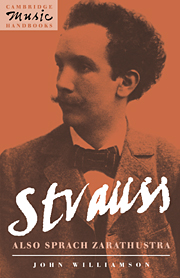4 - Composition and first performances
Published online by Cambridge University Press: 04 August 2010
Summary
If the intellectual background of Also sprach Zarathustra remains complex, its composition history is relatively straightforward. The dates traditionally accepted for its composition are those supplied by Steinitzer, 4 February to 24 August 1896. A copy of the full score in Strauss's hand survives today in Garmisch. According to Schuh, the first page is inscribed, ‘Begun 4 February 1896, my beloved Paula's birthday’, while Franz Trenner (Strauss's most recent cataloguer) gives the inscription ‘Begun on 4 February, completed on 24 August 1896, Munich’. Neither writer (nor Mueller von Asow) is entirely clear whether this is a fair copy or Strauss's original working score. The first sketches are described by Schuh as dating from February 1894, though by 9 July 1895 Strauss was still only at the stage of ‘Thoughts about a new tone poem’, which are listed in six categories. It is revealing of Strauss's approach to the work that these should be emotional states with no apparent reference to Nietzsche. In such words as ‘contemplation’ and ‘worship’ can be seen references to the ‘scientific’ and religious sections of the tone poem, but only with benefit of hindsight. ‘Doubting’ and ‘despair’ similarly are not without resonance in the light of ‘Das Grablied’ and ‘Der Genesende’, but ‘experience’ and ‘recognition’ are so vague as to convey little sense of a programme or musical content. Schuh describes them as ‘key words in the conception’, but they reflect a broad feeling for mood rather than specifics.
- Type
- Chapter
- Information
- Strauss: Also sprach Zarathustra , pp. 31 - 38Publisher: Cambridge University PressPrint publication year: 1993

